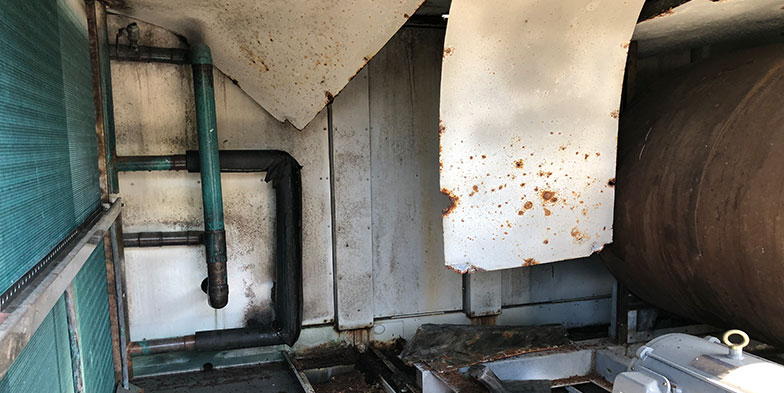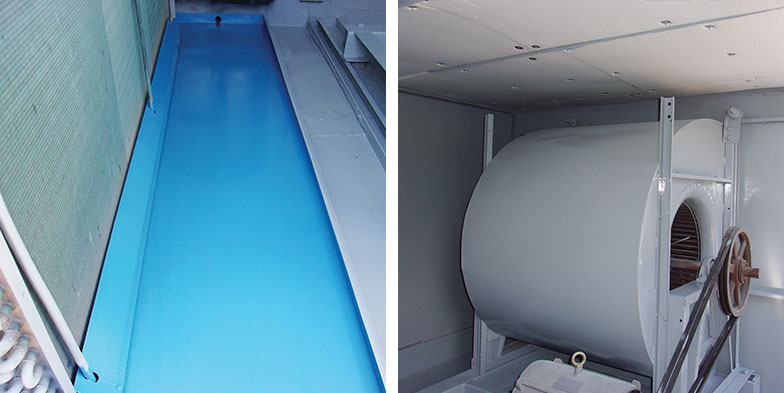
Commercial and especially institutional properties across the United State have to maintain aging infrastructure on a daily basis. One of the most critical components to a building’s health, occupant comfort and energy efficiency is the heating, ventilation and air conditioning (HVAC) systems, in particular air handling units (AHU) found on rooftops and in mechanical rooms.
It has been estimated that the mean age of a commercial building is nearly 50 years old, with many government and higher education buildings being much older. On average the HVAC equipment lifecycle is around 25 years, with rooftop AHU lifespans being a bit shorter due to environmental operating conditions. Most asset managers or facility directors look at replacing these AHUs or completely redesigning the system between the 15 to 20 year milestone.
But, considering the number of AHU, financial hard costs and downtime, is replacement the only option?
Consider this: the basic design and function of an AHU has changed very little in the last 100 years. Cabinet. Blower. Coil. Sure, more advanced control systems have been developed and implemented but they are only as good as how the AHU itself is performing. That or the controls must be reprogrammed to work with inefficiency at the AHU, which in turn can throw the entire building envelope out of balance. The good news is there are processes, like HVAC New LifeTM, that can restore the AHU to near factory specification for a fraction of the cost of redesign or replacement!
Why was HVAC invented in the first place? This may seem like a rhetorical question, but it bears mentioning: HVAC was invented for the comfort of the building occupants!
The HVAC of a building has a tremendous effect on the people within the indoor environment. Not the least of which is ventilation, and with that the air that is breathed. It has been estimated we breathe about 3,000 gallons of air day. The HVAC system is not only responsible for the exchange of air and thermal comfort in a building, but also keeping that air clean. Even with the best filtration, evaporator coils in the AHU can become fouled with dust, which in turn becomes a food source for microbes such as bacteria and fungi (mold). Microbials can cause a range of issues from unpleasant odors to full blown allergen triggers or worse which can affect the health and productivity of the building occupant. This can be costly to a business or institution.
Even with new equipment, IAQ issues can quickly compound. Routine cleaning of the AHU and especially the coils is always recommended. Hygienic cleaning is the important first step in the HVAC restoration. Chemical rinsing of the coil only superficially cleans and can eliminate some microbial odors. However, steam cleaning the interior of the AHU and evaporator coils goes beyond chemical cleaning in many ways. The increased pressure driving the steam penetrates completely through the coil to eliminate all fouling, while the high temperatures provide thorough microbial disinfection.
Beyond the benefits of steam coil cleaning, flexible, antimicrobial/antioxidant coatings and drain pan liners, as well as zero porosity, no-fiberglass insulation included in the restoration process improve both IAQ and equipment longevity.
In most cases, equipment replacement for existing buildings is a 1:1 swap. This means that AHU being replaced was already designed to be the right size for the portion of the facility it is servicing. Sometimes replacements involve a rethinking of the design or specification of the equipment. Of course, this can lead to additional downtime as previously referenced.
HVAC Restoration optimizes the AHU in place. This can be incredibly useful in situations with tight mechanical rooms such as historic buildings where the architecture cannot be altered to accommodate new equipment. Furthermore, HVAC restoration reduces the carbon footprint of replacement because is no need for new equipment to be transported to the site and old equipment removed and trucked away to the scrapyard. Speaking of scrapping, this too increases the carbon footprint of a replacement project in the energy it takes to break down the old equipment for recycling, the recycling process itself and/or just relegating the entire AHU to a landfill.
While there is no doubt that a new AHU will be more efficient than an older neglected one, units restored with the steam coil cleaning process can be just as efficient as new. Consider a recent case study conducted by Pure Air Control Services, Inc. and Georgia Tech University. M&V testing conducted before and after the cleaning, done independently from both parties, found that the steam cleaning process improved airflow by 42.6%, Delta-P by 22% and added 7 tons of cooling capacity to the system in four hours of cleaning!
Before Restoration

After Restoration

HVAC Restoration “increases the useful lifespan” of an asset. As such, restoration can be purchased and depreciated out of CAPEX just like replacement! This is a very lucrative benefit when comparing restoration and replacement during cost/benefit analyses. On average the hard costs of labor and materials for HVAC restoration are 1/10 that of HVAC replacement.
Because HVAC restoration can be purchased with CAPEX and the results bring the equipment to near new condition OPEX can be spared for use towards more critical maintenance issues. This is especially helpful with facilities that constantly operate in a deferred maintenance scenario. HVAC often falls into poor cleanliness and disrepair because of deferred maintenance. Restore it using CAPEX and the save OPEX for pressing concerns!
Whether undertaking an HVAC replacement or restoration program, the cornerstone data needed to proceed can be found in the facility’s Mechanical Inventory. Hopefully, this is a complete resource that includes all the nomenclature, specifications, serial numbers, ages and service records of the HVAC equipment used in the facility. If a facility doesn’t have a full inventory on hand it is recommended that a total assessment be made, including visual inspection notes and M&V testing prior to any decision being made. This is critical in proactive planning from a maintenance standpoint regardless of plans for replacement or restoration. It will also be extremely helpful in prioritizing AHUs for when and what type of restoration is needed. It is also a key component in logging for a preventative maintenance program that includes annual steam coil cleaning to maintain energy efficiency.
Of course, not every single AHU is a candidate for HVAC restoration and solid Mechanical Inventory data should flag the units that absolutely need to be replaced. But at the same time, it will also demonstrate that the vast majority of units can and should be restored for many additional years of operations and cost savings.

Pure Air is committed to excellence in all aspects of Indoor Air Quality. The company’s fundamental purpose is to provide professional environmental consulting, engineering and evaluation through building diagnostic protocols, laboratory support services, and building/HVAC system remediation services.